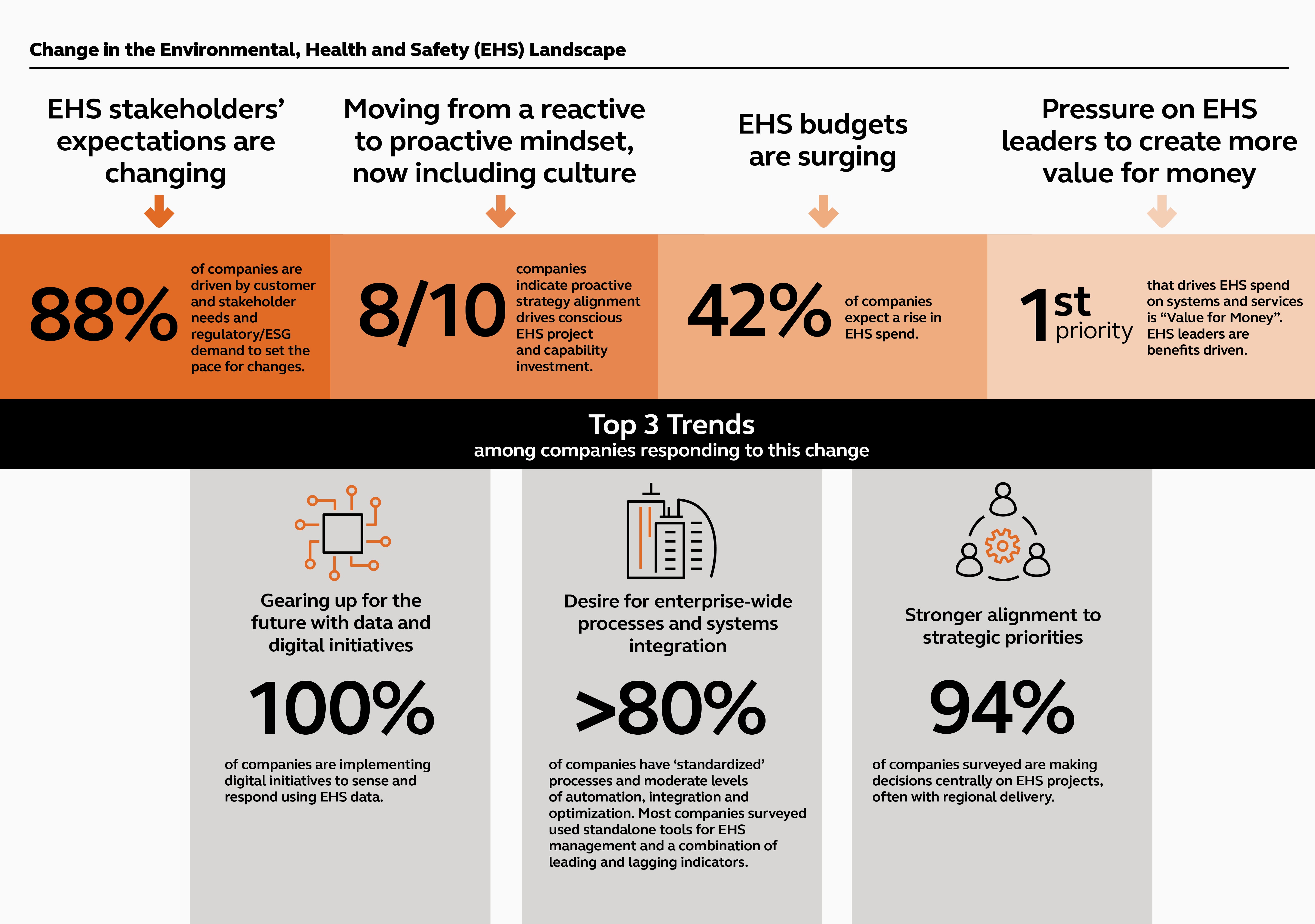There is an emerging groundswell of change in the Environmental, Health and Safety (EHS) landscape. Companies are expected not only to improve their performance, but to set the pace for change amidst burgeoning regulatory and environmental, social and governance (ESG) needs.
To shift from a reactive mindset and better respond to stakeholders’ needs, EHS leaders are prioritizing risk management and pushing for value creation as they devise proactive corporate EHS strategies. Given that most EHS compliance assurance budgets are set to see a surge over the next 12 months, EHS leaders are under greater pressure today to prioritize spending on ESG and sustainability disclosure regulations and to operate with a benefits-driven philosophy while guiding investment decisions in EHS staffing, structures, processes and tools.
This paradigm is driving a new way of thinking and, subsequently, a new playbook for EHS optimization within best-in-class organizations. Our work with benchmarking over 30 multinational companies across various market sectors over the last year alone has revealed three main themes among companies aligning to this paradigm:
1. Stronger structural alignment and integrated cross-functional governance of strategic priorities within the broader organization,
2. A desire to achieve enterprise-wide integration of processes, systems and data and increase focus on standardization and automation, and
3. An ambition to invest for the future through data and digital initiatives that not only sense and respond to changing EHS stimuli but position the organization to predict and act with insight.
Read on to explore how some of the best-in-class companies are structuring their EHS organizations and processes to drive towards EHS excellence and truly become fit for future.

EHS strategy and complexity drives structure
The operational risk, size and legacy of an organization, as well as the complexity of process, typically drive EHS structures and spending, another reason EHS functions are shifting from decentralized and hybrid models to more centralized management. Centralized EHS organizations are becoming nimbler and adept at responding to their operation’s customers’ needs like increased need for safety, compliance and sustainability—with operations and the business units stepping up to own safety, the role of EHS is changing from player to coach.
Benefits of centralization are increasingly being achieved through integrated global oversight and governance of businesses (regions, segments or operating units), processes, and performance (e.g., through centralized governance or transformation offices). In this structure, centers of excellence and high levels of collaboration and organizational competency exist.
Strategy also drives maturity in EHS performance management
Centralized EHS structures often influence increases in standardization and consistency in the adoption of EHS policy, procedure, systems, and performance indicators. The added centralization of decision-making also unlocks the benefits of utilizing EHS data to drive actionable insights.
Consolidation of data visualization and insights through centralized analytical tools is a common industry trend today. EHS executives are seeking a single pane view of business operations to monitor core KPIs often facilitated by central data teams with tools like Microsoft Power BI and Tableau. This shift allows for flexibility in contextualizing EHS data with layers of operational data that sit outside of environmental management information systems to conduct proactive analysis to identify and mitigate risks.
Integrated audit & compliance assurance processes to drive efficiencies
Organizations are often lost in the maze of myriad EHS audit procedures and are looking more and more to integrate and harmonize procedures to increase simplicity and standardization and reduce facility disruption.
This trend reinforces the value of strategically developing audits with targeted compliance assurance processes and metrics to align with organizational goals and needs, thereby maximizing insights.
Structure and culture drive high performing management systems
Leadership, engagement and culture are key to creating a sense of connection and pride in EHS outcomes within an organization, especially as talent attraction and retention continue to be a challenge across the industry.
The proactive EHS culture typically seen in centralized organizations prompts data-driven action and unified approaches to EHS excellence. This is characterized by a culture of caring, accountability, proactivity, learning, transparency and inclusion. Organizations that continually engage with their employees, customers, suppliers and key external stakeholders are successful in integrating EHS into their business practices and strategies. Conversely, cultures focused on stringent compliance disincentivizes reporting incidents, issues and problems and creates a narrow focus to EHS management.
Culture often stems from the corporate ethos, principles for long term sustainment and lived values and behaviors—this type of culture is risk-based, proactive, inclusive and responsive to change!
Are you employing a strategic and proactive approach to EHS? Are you investing to be fit for future with a balanced focus on people, process, system, data and culture? We’d love to hear from you about your journey towards EHS Excellence and partner with you to unlock transformational benefits.


